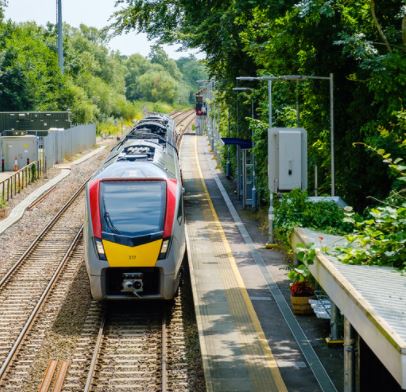Carbon calculator shows how people in East Anglia are taking the right steps to reduce carbon footprint
November 15, 2021

Carbon emissions in East Anglia travel in the right direction when people switch from car to train, figures reveal.
To mark today’s COP26 summit focus on the theme of transport, Greater Anglia put five of its most popular routes through a carbon calculator to demonstrate the enormous carbon savings that can be made by choosing to travel sustainably.
It reveals that last month almost a quarter of a million people travelled on the five routes and together saved a whopping four million kilograms of CO2e from being emitted into the atmosphere. That is equivalent to one million trees absorbing CO2 for nearly two years.1
The calculated routes were:
- Chelmsford to London.
Over 196,000 people used the route last month, saving over 1.3 million kg of CO2e from being released into the atmosphere if they had instead travelled by car.
- London – Stansted Airport
Over 162,000 people used the route last month, saving over 1.35 million kg of CO2e from being released into the atmosphere if they had instead travelled by car.
- Colchester – London
Over 104,000 people used the route last month, saving over 1.2 million kg of CO2e from being released into the atmosphere if they had instead travelled by car.
- Norwich – Cambridge
Over 10,600 people used the route last month, saving over 164,000 kg of CO2e from being released into the atmosphere if they had instead travelled by car.
- Ipswich – Lowestoft
Over 1,400 people used the route last month, saving over 22,000 kg of CO2e from being released into the atmosphere if they had instead travelled by car.
The calculator us available at Greater Anglia’s new online Green Hub – greateranglia.co.uk/carbon-calculator
According to the Department for Transport*, road transport is the biggest driver of CO2 emissions in the UK.
In 2019, domestic transport was responsible for emitting 122 million tonnes of carbon dioxide equivalent (CO2e). This means transport is the largest emitting sector of greenhouse gas emissions, producing 27% of the UK’s total emissions in 2019. Of this, the majority – 91 per cent – came from road transport vehicles.
Rail, however, accounts for just 1.4 per cent of transport emissions despite representing 10% of all journeys – and the industry has a target to become net zero by 2050.
Greater Anglia’s Managing Director, Jamie Burles, said: “We want to help people build back better as we emerge from the pandemic and get life moving again and these figures show just what a difference people can make to their carbon footprint when they choose to travel more sustainably.
“The railway in East Anglia can lead the green recovery from the pandemic by being a much greener way to travel – and our new fleet of trains will contribute even more thanks to their more environmentally friendly features which reduce CO2 and particulate emissions in the region further still and offer a convenient, comfortable alternative to the car.”
The carbon calculator reveals that for most journeys, going by car emits four times more CO2e than going by train.
For example:
- A journey from Norwich to London Liverpool Street saves 28.14 kg of CO2e (equivalent to powering a house for 32 hours)
- A journey from Cambridge to Norwich saves 12.95 kg of CO2e (equivalent to boiling 185 kettles)
- A journey from Ipswich to Lowestoft saves 8.74kg of CO2e (equivalent to 90 hours of TV)
- A journey from Colchester to Clacton-On-Sea saves 3 kg of CO2e (equivalent to boiling 42 kettles)
- A journey from Bishop’s Stortford to Tottenham Hale saves 4.84 kg of CO2e (equivalent to powering a house for 7 hours)
- A journey from Southend Victoria to London Liverpool Street saves 7.68 kg of CO2e (equivalent to boiling 109 kettles)
Last year, Greater Anglia’s Scope 1 and 2 CO2 emissions reduced by 11 per cent.
This is in addition to the 11% reduction in 2019/20, meaning that the company’s CO2 emissions have reduced by 21% over the last two years.